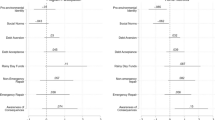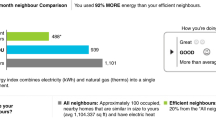Abstract
The best technology does no good unless people use it. Thus, the future of biofuels depends not only on development of effective and efficient technologies but also on the social, economic, and political climate within which people decide to use or avoid these new fuel sources and technologies. On a social psychological level, individual behaviors are often guided by people’s attitudes toward the behavior or objects involved and by the norms established by others within the social setting. Therefore, understanding technology adoption requires an understanding of how public attitudes and beliefs are formed or changed, as well as the implications of these changes for social norms. We provide an overview of basic social psychology research connecting attitudes and norms to individual behavior, and we describe implications of these social factors for biofuel development and use.
Similar content being viewed by others
References
Ajzen I, Fishbein M (1977) Attitude–behavior relations: a theoretical analysis and review of empirical research. Psychol Bull 84:888–918
Ajzen I, Fishbein M (2005) The influence of attitudes on behavior. In: Albarracin D, Johnson BT, Zanna MP (eds) The handbook of attitudes. Erlbaum, Mahwah, NJ, pp 173–221
Allport GW (1935) Attitudes. In: Murchison C (ed) Handbook of social psychology. Clark University Press, Worcester, MA, pp 798–884
Asch SE (1951) Effects of group pressure upon the modification and distortion of judgment. In: Guetzkow H (ed) Groups, leadership, and men. Carnegie University Press, Pittsburgh, PA, pp 177–190
Asch SE (1955) Studies of independence and conformity: a minority of one against a unanimous majority. Psychol Monogr 70:1–70
Baron RS, Vandello JA, Brunsman B (1996) The forgotten variable in conformity research: impact of task importance on social influence. J Pers Soc Psychol 71:915–927
Braun R (2002) People’s concerns about biotechnology: some problems and some solutions. J Biotech, 98:3–8
Cacioppo JT, Petty RE (1979) Effects of message repetition and position on cognitive responses, recall, and persuasion. J Pers Soc Psychol 37:97–109
Cacioppo JT, Petty RE, Kao CF, Rodriguez R (1986) Central and peripheral routes to persuasion: an individual difference perspective. J Pers Soc Psychol 51:1032–1043
Chaiken S (1980) Heuristic versus systematic information processing in the use of source versus message cues in persuasion. J Pers Soc Psychol 39:752–766
Chaiken S, Liberman A, Eagly AH (1989) Heuristic and systematic processing within and beyond the persuasion context. In: Uleman JS, Bargh JA (eds) Unintended thought. Guilford, New York, pp 212–252
Chaiken S, Maheswaran D (1994) Heuristic processing can bias systematic processing: effects of source credibility, argument ambiguity, and task importance on attitude judgment. J Pers Soc Psychol 66:460–473
Cialdini RB (2007) Written testimony to U.S. House of Representatives hearing on “Contributions of the Social Sciences to the Energy Challenge.” Subcommittee on Research and Science Education, Committee on Science and Technology. Available at: http://science.house.gov/publications/hearings_markups_details.aspx?NewsID=1956 (September)
Cialdini RB, Reno RR, Kallgren CA (1990) A focus theory of normative conduct: recycling the concept of norms to reduce littering in public places. J Pers Soc Psychol 58:1015–1026
Clark JK, Wegener DT, Fabrigar LR (2008) Attitude ambivalence and message-based persuasion: motivated processing of proattitudinal information and avoidance of counterattitudinal information. Pers Soc Psychol Bull 34:565–577
Davidson AR, Yantis S, Norwood M, Montano DE (1985) Amount of information about the attitude object and attitude–behavior consistency. J Pers Soc Psychol 49:1184–1198
Deutsch M, Gerard HB (1955) A study of normative and informational social influence upon individual judgment. J Abnormal Soc Psychol 51:629–636
Edwards K, Smith EE (1996) A disconfirmation bias in the evaluation of arguments. J Pers Soc Psychol 71:5–24
Eurobarameter (2000) Report of the European Commission. Released April 18, 2000, available at: http://europa.eu.int/comm/research/press_en.html
Fabrigar LR, MacDonald T, Wegener DT (2005) The structure of attitudes. In: Albarracin D, Johnson BT, Zanna MP (eds) The handbook of attitudes. Erlbaum, Mahwah, NJ, pp 79–124
Fazio RH (1995) Attitudes as object–evaluation associations: determinants, consequences, and correlates of attitude accessibility. In: Petty RE, Krosnick JA (eds) Attitude strength: antecedents and consequences. Erlbaum, Mahwah, NJ, pp 247–282
Fazio RH, Zanna MP (1981) Direct experience and attitude behavior consistency. In: Berkowitz L (ed) Advances in experimental social psychology. vol. 14. Academic, New York, pp 161–202
Goy PA, Duesing JH (1996) Assessing the environmental impact of gene transfer to wild relatives. Bio/Technology 14:39–40
Himmelfarb S, Youngblood J (1969) Effects of factual information on creating resistance to emotional appeals. Psychon Sci 14:267–270
Homer PM, Kahle LR (1988) A structural equation test of the value–attitude–behavior hierarchy. J Pers Soc Psychol 54:638–646
Kallgren CA, Wood W (1985) Access to attitude-relevant information in memory as a determinant of attitude–behavior consistency. J Exp Soc Psychol 22:328–338
Krauss RM, Freedman JL, Whitcup M (1978) Field and laboratory studies of littering. J Exp Soc Psychol 14:109–122
Levine JM, Russo EM (1987) Majority and minority influence. Rev Pers Soc Psychol 8:13–54
Lewan PC, Stotland E (1961) The effects of prior information on susceptibility to an emotional appeal. J Abnormal Soc Psychol 62:450–453
Maio GR, Bell DW, Esses VM (1996) Ambivalence and persuasion: the processing of messages about immigrant groups. J Exp Soc Psychol 32:513–536
Maio GR, Olson JM (2000) (eds) Why we evaluate: functions of attitudes. Erlbaum, Mahwah, NJ
Meilan R (2004) Molecular biology of forest trees. In: Burley J, Evans J, Youngquist J (eds) Encyclopedia of forest sciences. Academic, Oxford, UK, pp 229–236
Midden C, Meijnders A, Hübner G, van den Hoogen W (2003) Implementation barriers of energy from biomass: psychological factors. Technische Universiteit Eindhoven (TU/e), Eindhoven
Nolan JM, Schultz PW, Cialdini RB, Goldstein NJ, Griskevicius V (2008) Normative social influence is underdetected. Pers Soc Psychol Bull 34:913–923
Petty RE, Cacioppo JT (1986) The Elaboration Likelihood Model of persuasion. In: Berkowitz L (ed) Advances in experimental social psychology. vol. 19. Academic, New York, pp 123–205
Petty RE, Cacioppo JT, Goldman R (1981) Personal involvement as a determinant of argument-based persuasion. J Pers Soc Psychol 41:847–855
Petty RE, Cacioppo JT, Schumann DW (1983) Central and peripheral routes to advertising effectiveness: the moderating role of involvement. J Consum Res 10:135–146
Petty RE Haugtvedt CP Smith SM (1995) Elaboration as a determinant of attitude strength: creating attitudes that are persistent, resistant, and predictive of behavior. In: Petty RE, Krosnick JA (eds) Attitude strength: antecedents and consequences. Erlbaum, Mahwah, NJ, pp 93–130
Petty RE, Krosnick JA (1995) Attitude strength: antecedents and consequences. Erlbaum, Mahwah, NJ
Petty RE, Wegener DT (1998) Attitude change: multiple roles for persuasion variables. In: Gilbert D, Fiske S, Lindzey G (eds) The handbook of social psychology. 4th edn. McGraw-Hill, New York, pp 323–390
Petty RE, Wegener DT (1999) The Elaboration Likelihood Model: current status and controversies. In: Chaiken S, Trope Y (eds) Dual process theories in social psychology. Guilford, New York, pp 41–72
Potrykus I (2001) Golden rice and beyond. Plant Phys 125:1157–1161
Pratkanis AR, Breckler SJ, Greenwald AG (eds) (1989) Attitude structure and function. Erlbaum, Hillsdale, NJ
Reno RR, Cialdini RB, Kallgren CA (1993) The transsituational influence of social norms. J Pers Soc Psychol 64:104–112
Rohracher H, Bogner T, Späth P, Faber F (2004) Improving the public perception of bioenergy in the EU. Available at: http://ec.europa.eu/energy/res/sectors/bioenergy_publications_en.htm
Rohrer JH, Baron SH, Hoffman EL et al (1954) The stability of autokinetic judgments. J Abnormal Soc Psychol 49:595–597
Schultz PW, Nolan JM, Cialdini RB, Goldstein NJ, Griskevicius V (2007) The constructive, destructive, and reconstructive power of social norms. Psychol Sci 18:429–434
Sherif MA (1935) A study of some social factors in perception. Arch Psychol 187:60
Sherif MA (1937) An experimental approach to the study of attitudes. Sociometry 1:90–98
Singer E (1990) Reference groups and social evaluations. In: Rosenberg M, Turner RH (eds) Social psychology: sociological perspectives. Transaction, New Brunswick, NJ
Trafimow D, Finlay KA (1996) The importance of subjective norms for a minority of people: between-subjects and within-subjects analyses. Pers Soc Psychol Bull 22:820–828
Wegener DT, Downing J, Krosnick JA, Petty RE (1995) Strength-related properties of attitudes: measures, manipulations, and future directions. In: Petty RE, Krosnick JA (eds) Attitude strength: antecedents and consequences. Erlbaum, Mahwah, NJ, pp 455–487
Wegener DT, Kelly JR, Parker GR, Parker S, Cooper HL, Widdows R, Feinberg RA, Goodman D, Bodner GM (2008) Knowledge, beliefs, and attitudes: foundations for research on the human dynamics of energy use. Raw data. Purdue University, West Lafayette, IN
Weigel RH Newman LS (1976) Increasing attitude–behavior correspondence by broadening the scope of the behavior measure. J Pers Soc Psychol 33:793–802
Wood W (1982) Retrieval of attitude-relevant information from memory: effects on susceptibility to persuasion and on intrinsic motivation. J Pers Soc Psychol 42:798–810
Wood W Kallgren CA Preisler RM (1985) Access to attitude-relevant information in memory as a determinant of persuasion: the role of message attributes. J Exp Soc Psychol 21:73–85
Zanna MP, Olson JM, Fazio RH (1980) Attitude–behavior consistency: an individual difference perspective. J Pers Soc Psychol 38:432–440
Author information
Authors and Affiliations
Corresponding author
Additional information
This work was supported by a seed grant from the Purdue Energy Center at Discovery Park and by a grant from the National Science Foundation (Human Social Dynamics no. 0729348).
Rights and permissions
About this article
Cite this article
Wegener, D.T., Kelly, J.R. Social Psychological Dimensions of Bioenergy Development and Public Acceptance. Bioenerg. Res. 1, 107–117 (2008). https://doi.org/10.1007/s12155-008-9012-z
Received:
Accepted:
Published:
Issue Date:
DOI: https://doi.org/10.1007/s12155-008-9012-z




